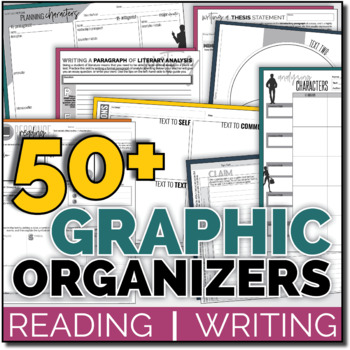ELA Graphic Organizers for Essay Writing, Literature, Reading Non-Fiction & More
- Zip
What educators are saying
Description
Graphic organizers are an extremely powerful tool to help students visualize, organize, and comprehend information. If you are looking for ways to scaffold and differentiate, graphic organizers are highly effective in the ELA classroom: they guide students with reading strategies, and the writing process.
NOTE: These organizers are designed to be PRINTED. If you would prefer a DIGITAL VERSION to use with Google Slides™, CLICK HERE!
As an ELA teacher, it is useful to have a range of tools on hand to help students with the development of key skills: these graphic organizers do exactly that! Additionally, these 50 organiser pages are designed with secondary students in mind: engaging, visually appealing, and constructive.
TEACHERS LIKE YOU SAID:
- ⭐⭐⭐⭐⭐ Rachel P. said, "This contains every organizer you could possibly need for English. Used across middle and high school. Students found the sheets helpful for organizing their thoughts/writing and it was easier for me to grade.
- ⭐⭐⭐⭐⭐ Mrs Middle MindEd. said, "These were a perfect addition to supplement lessons. Students really enjoyed working with these and I saw great growth in their reading responses."
CONTENTS:
Analyzing Non-Fiction Reading
- Describe, Infer, Question
- Analyzing Ethos, Pathos, Logos
- Cause and Effect
- Making Connections
- Fact or Opinion
- Making Inferences
- Making Predictions
- Articles: Who, What, Where, When, Why, How
- Taking Notes
- Persuasive Techniques
- Questioning What You Read
- Responding with Your Opinions
Creative Writing
- Planning a Story
- Creating Characterization
- Planning Characters
- Plot Planning
- Freytag's Pyramid
- Story Planning
- Designing the Setting
Essay Writing Process
- Building an Argument
- 5 Paragraph Plan
- Idea Generation
- Paragraph Planning
- Recording Quotations
- Writing a Thesis Statement
- Understanding the Essay Question
- Writing to Persuade
Reading Literature
- Analyzing Characters
- Chapter Response
- Character Chart
- Analyzing Characterization
- Claim, Support, Question
- Graphic Novel Page
- Identifying Theme
- Plot Stucture
- Mind-mapping a Poem
- Analyzing a Poem
- Questioning What You Read
- Timeline
Misc.
- Before Reading
- Compare and Contrast
- Mind-Map
- Planning a Summary
- Storyboard
- Venn Diagram with Two Texts
- Venn Diagram with Three Texts
- Square Venn Diagram
- Vocabulary
- Web
************************************************************
You might also like:





